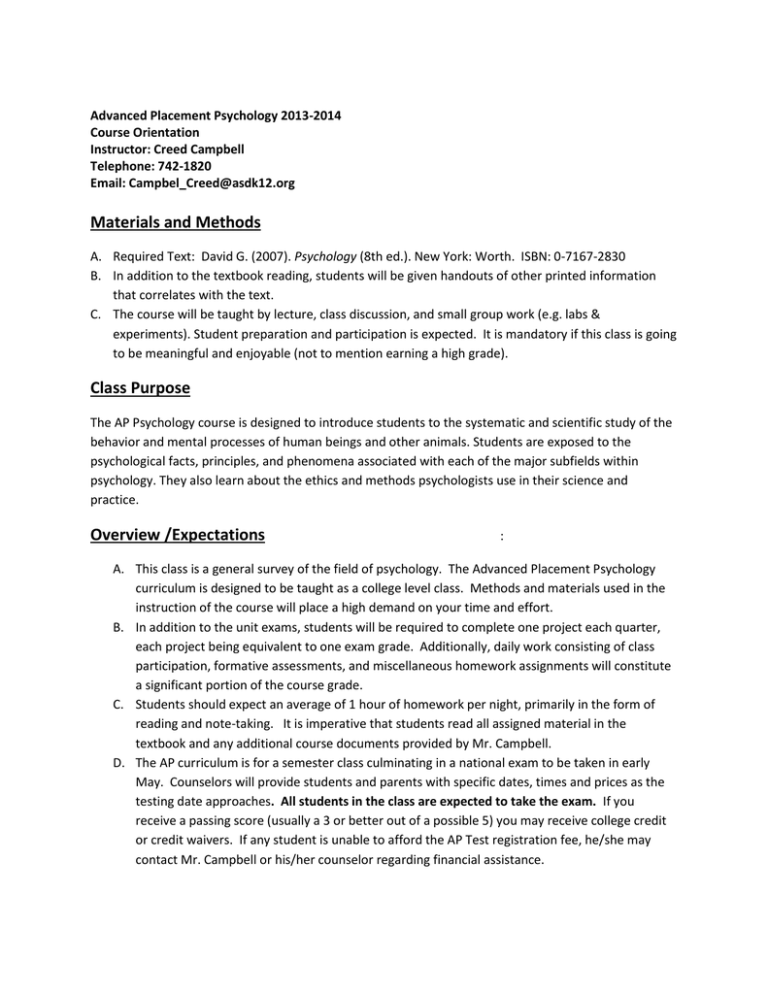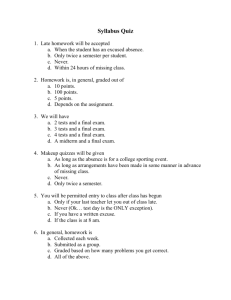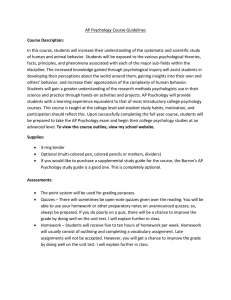AP-Psychology - Bartlett High School
advertisement

Advanced Placement Psychology 2013-2014 Course Orientation Instructor: Creed Campbell Telephone: 742-1820 Email: Campbel_Creed@asdk12.org Materials and Methods A. Required Text: David G. (2007). Psychology (8th ed.). New York: Worth. ISBN: 0-7167-2830 B. In addition to the textbook reading, students will be given handouts of other printed information that correlates with the text. C. The course will be taught by lecture, class discussion, and small group work (e.g. labs & experiments). Student preparation and participation is expected. It is mandatory if this class is going to be meaningful and enjoyable (not to mention earning a high grade). Class Purpose The AP Psychology course is designed to introduce students to the systematic and scientific study of the behavior and mental processes of human beings and other animals. Students are exposed to the psychological facts, principles, and phenomena associated with each of the major subfields within psychology. They also learn about the ethics and methods psychologists use in their science and practice. Overview /Expectations : A. This class is a general survey of the field of psychology. The Advanced Placement Psychology curriculum is designed to be taught as a college level class. Methods and materials used in the instruction of the course will place a high demand on your time and effort. B. In addition to the unit exams, students will be required to complete one project each quarter, each project being equivalent to one exam grade. Additionally, daily work consisting of class participation, formative assessments, and miscellaneous homework assignments will constitute a significant portion of the course grade. C. Students should expect an average of 1 hour of homework per night, primarily in the form of reading and note-taking. It is imperative that students read all assigned material in the textbook and any additional course documents provided by Mr. Campbell. D. The AP curriculum is for a semester class culminating in a national exam to be taken in early May. Counselors will provide students and parents with specific dates, times and prices as the testing date approaches. All students in the class are expected to take the exam. If you receive a passing score (usually a 3 or better out of a possible 5) you may receive college credit or credit waivers. If any student is unable to afford the AP Test registration fee, he/she may contact Mr. Campbell or his/her counselor regarding financial assistance. E. There will be periods of frustration and self-doubt over the demanding work schedule. There have been many others who have experienced what you are going through. Be sure to schedule your time, plan ahead, and keep playtime activities in check with reality. When you wait until the last minute to study, you will pay the price academically. F. Don’t feel hesitant to talk with me for assistance in course work management. One of our goals is to develop good study habits and study skills. Absences/Missing Work A. Students will be given assignments on a regular basis. Some will be worked on during class time; others will be homework assignments. LATE WORK WILL NOT BE ACCEPTED UNLESS YOU HAVE AN EXCUSED ABSENCE. Extra credit will not be offered to “make up” for assignments that you chose not to complete. B. Students missing an exam due to an excused absence must, on the day of their return, make arrangements to makeup the exam. If a student does not contact me on the day of their return to arrange a makeup test date, a zero will be recorded in the grade book. The absence must have been excused through the office per standard school policy. C. In the event that students are absent (excused) for an extended period of time, exceptions will be made. Immediately upon students return, it is their responsibility to seek me out to make arrangements for make-up work. Grades You will be graded on the quality of your work demonstrated by: Objective test questions (multiple- choice) Free Response test questions Research papers Participation in small group and class discussion Individual and small group presentations Written homework assignments and labs A. Individual assignments, quizzes and tests are each given a point value. Your grade is determined by the percentage of points you earn out of the total points possible. i. 90-100% = A ii. 80-89% = B iii. 70-79% = C iv. 60-69% = D v. Below 60% = F B. Grades in an AP class do take into consideration the difficult of this course in relation to regular or even honors classes. AP classes are therefore weighted differently in calculating your grade-point average. This is to encourage students to stay in the class despite the fact that it is more difficult to earn a high grade. The philosophy is that this class is a worthwhile academic experience that should not be avoided just to protect one’s GPA. Therefore, when calculating your GPA, your grade in an AP class will count as follows: A=5 points; B = 4 points; C=3 points; D=2 points; F=0 points C. All current grades are accessible through Zangle. Additionally, students may request printed progress reports. Pay attention to all graded work returned to you and keep track of your own progress in between printed grade reports. D. Should you wish to discuss your class work, individual problems, or need help come by my room before or after school or during lunch. My concern for you is not limited to your success on the national exam. Test and Quizzes A. Unit Tests – At the conclusion of each unit, a test will be given. Tests are announced well in advance; therefore only those who are absent during the day of a test should need a make-up. Each unit test will be 50 multiple choice questions and 1 free-response question. B. Cumulative Tests – To help students prepare for the AP Exam in May, a cumulative test will be given at the end of the first, second, and third quarters prior to the AP Exam. Each test will cover all the material from the beginning of the school year to that point. C. Semester Final Exams – At the end of each semester, a final exam will be given consisting of 200 questions. The questions will be taken directly from previous unit and cumulative tests from that semester. The second final exam will NOT be cumulative for the complete school year. D. Quizzes – Announced or unannounced quizzes may be given at any time during the school year. Usually quizzes are based on the activities of the previous day or the assigned reading for the day. IMPORTANT – You must keep up with the assigned reading to succeed on the quizzes and tests. There will be material on tests and quizzes that is not addressed in lectures/class discussions, so consider yourself warned. Notes Students will be required to maintain Cornell-Style notes for all lectures and the assigned reading for each unit. Students will be provided with a template to use. While students are not required to use the template for their notes, they are required to take and submit notes according to a prescribed format, which will be presented during the first week of class. At the end of each unit, students will be required to submit their notes to be graded. In addition to adhering to the prescribed format, consider the following information regarding your course note: 1. Date your notes to assist you in review. 2. Write your notes in your own words and with your own questions/impressions; your notes should be more than what I discuss in class or what you read in the book. 3. Don’t write something you don’t understand without at least asking about it. 4. Review your class notes each day while they are fresh in your mind. Go back and add to them, expand on them in any way to help you better remember and understand them. Note any questions or points of clarification to bring up during the next class meeting. 5. If you are absent, you are responsible for getting notes from other students. Class Schedule Mon. & Fri - 50 minutes Tues- No class Wed & Thur. - 80 minutes Course Outline These are the major content areas covered by the AP Psychology Exam, as well as the approximate percentages of the multiple-choice section that are devoted to each area. I . History and Approaches . . . . . . . . . . . . . . . . . . . . . . . . . . . . . . . . . . . . . . . . . . . 2–4% A . History of Psychology B . Approaches 1 . Biological 2 . Behavioral 3 . Cognitive 4 . Humanistic 5 . Psychodynamic 6 . Sociocultural 7 . Evolutionary 8 . Biopsychosocial C . Subfields in Psychology II . Research Methods . . . . . . . . . . . . . . . . . . . . . . . . . . . . . . . . . . . . . . . . . . . . . . . 8–10% A . Experimental, Correlational, and Clinical Research B . Statistics 1 . Descriptive 2 . Inferential C . Ethics in Research III . Biological Bases of Behavior . . . . . . . . . . . . . . . . . . . . . . . . . . . . . . . . . . . . . . 8–10% A . Physiological Techniques (e .g ., imaging, surgical) B . Neuroanatomy C . Functional Organization of Nervous System D . Neural Transmission E . Neuroplasticity F . Endocrine System G . Genetics H . Evolutionary Psychology IV . Sensation and Perception . . . . . . . . . . . . . . . . . . . . . . . . . . . . . . . . . . . . . . . . . . 6–8% A . Thresholds and Signal Detection Theory B . Sensory Mechanisms C . Attention D . Perceptual Processes V . States of Consciousness . . . . . . . . . . . . . . . . . . . . . . . . . . . . . . . . . . . . . . . . . . . 2–4% A . Sleep and Dreaming B . Hypnosis C . Psychoactive Drug Effects VI . Learning . . . . . . . . . . . . . . . . . . . . . . . . . . . . . . . . . . . . . . . . . . . . . . . . . . . . . . . . 7–9% A . Classical Conditioning B . Operant Conditioning C . Cognitive Processes D . Biological Factors E . Social Learning VII . Cognition . . . . . . . . . . . . . . . . . . . . . . . . . . . . . . . . . . . . . . . . . . . . . . . . . . . . . . 8–10% A . Memory B . Language C . Thinking D . Problem Solving and Creativity VIII . Motivation and Emotion . . . . . . . . . . . . . . . . . . . . . . . . . . . . . . . . . . . . . . . . . . . 6–8% A . Biological Bases B . Theories of Motivation C . Hunger, Thirst, Sex, and Pain D . Social Motives E . Theories of Emotion F . Stress IX . Developmental Psychology . . . . . . . . . . . . . . . . . . . . . . . . . . . . . . . . . . . . . . . . 7–9% A . Life-Span Approach B . Research Methods (e .g ., longitudinal, cross-sectional) C . Heredity–Environment Issues D . Developmental Theories E . Dimensions of Development 1 . Physical 2 . Cognitive 3 . Social 4 . Moral F . Sex and Gender Development X . Personality . . . . . . . . . . . . . . . . . . . . . . . . . . . . . . . . . . . . . . . . . . . . . . . . . . . . . . 5–7% A . Personality Theories and Approaches B . Assessment Techniques C . Growth and Adjustment XI . Testing and Individual Differences . . . . . . . . . . . . . . . . . . . . . . . . . . . . . . . . . . 5–7% A . Standardization and Norms B . Reliability and Validity C . Types of Tests D . Ethics and Standards in Testing E . Intelligence XII . Abnormal Behavior . . . . . . . . . . . . . . . . . . . . . . . . . . . . . . . . . . . . . . . . . . . . . . . 7–9% A . Definitions of Abnormality B . Theories of Psychopathology C . Diagnosis of Psychopathology D . Types of Disorders 1 . Anxiety 2 . Somatoform 3 . Mood 4 . Schizophrenic 5 . Organic 6 . Personality 7 . Dissociative XIII . Treatment of Abnormal Behavior . . . . . . . . . . . . . . . . . . . . . . . . . . . . . . . . . . . 5–7% A . Treatment Approaches 1 . Psychodynamic 2 . Humanistic 3 . Behavioral 4 . Cognitive 5 . Biological B . Modes of Therapy (i .e ., individual, group) C . Community and Preventive Approaches XIV . Social Psychology . . . . . . . . . . . . . . . . . . . . . . . . . . . . . . . . . . . . . . . . . . . . . . . 8–10% A . Group Dynamics B . Attribution Processes C . Interpersonal Perception D . Conformity, Compliance, Obedience E . Attitudes and Attitude Change F . Organizational Behavior G . Aggression/Antisocial Behavior H . Cultural Influences



